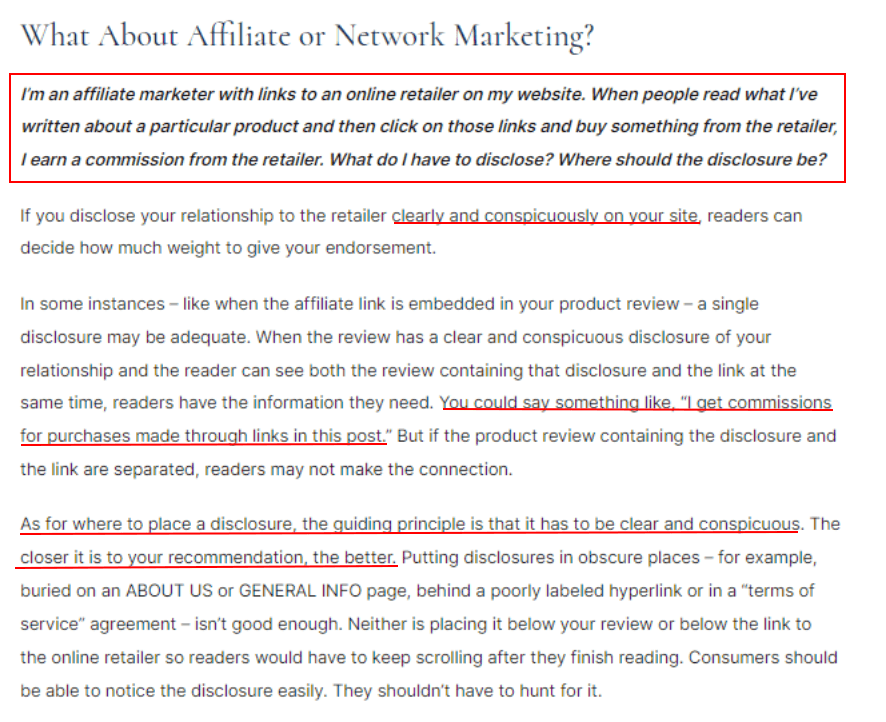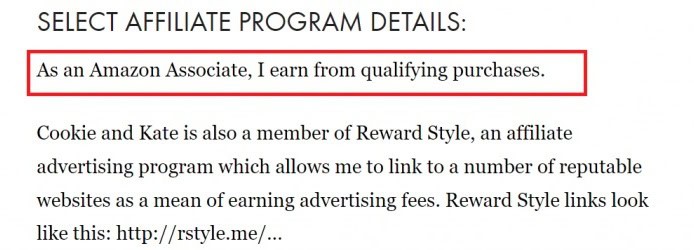Imagine earning passive income from sales while you tackle other tasks related to your small business.
With affiliate marketing, it’s possible, as you can open up more revenue streams. Depending on the affiliate structure, affiliate marketing generates profit from sales, signups, or visits.
Small businesses need all the revenue streams they can get, which makes affiliate marketing a valuable tool. In this blog post, we’ll look at the different affiliate marketing examples. We’ll also look at the benefits, actionable insights, and tips for success.
Table of Contents
Key Takeaways
- Partaking in an online store or affiliate program can be an excellent way for your small business to expand on revenue options that can keep you afloat. You may also earn new customers.
- Implementing an affiliate marketing program requires choosing an industry or niche you know a lot about, selecting partners carefully, and disclosing that you have an affiliate who will earn a commission on products and services purchased.
Understanding Affiliate Marketing
Let’s take a closer look at affiliate marketing.
Under an affiliate marketing arrangement, you’d work as a merchant selling products or an affiliate reaping the rewards. When a customer makes a purchase, the affiliate receives a commission, and the merchant receives the sales dollars.
The checkout process for a product is no different than usual; the prices are the same. The only difference is the customer uses an affiliate link when checking out.
And does affiliate marketing work? Absolutely! More than 80% of brands use it for sales and brand awareness, and it drives more than 15% of all United States internet orders.
Affiliate marketing has several components I want to unpack in detail. Understanding each will help you see how this form of marketing successfully comes together.
Affiliates
Affiliates directly receive benefits, usually income in the form of a commission, for promoting products and services belonging to merchants.
Merchants
Merchants are those whose products and services an affiliate will promote.
The affiliate doesn’t directly sell the merchant’s products, and those products and services are still available on the merchant’s website for sale.
So, why do merchants welcome affiliates at all? It’s simple. Their products or services sell more with affiliate promotions, and they receive a chunk of the sales made in an affiliate marketing deal.
Affiliate networks
Many affiliates, such as Amazon, have affiliate networks. These platforms introduce affiliates to affiliate programs and viable merchants. They may also have bonus features such as legal safeguards and faster payment processing.
Consumers
Of course, you can’t have a successful affiliate marketing plan without consumers. They’re the ones who buy the products and services to keep your business afloat.
Learn about EngageBay’s partner programs here.
3 Examples of Successful Affiliate Marketing Campaigns
Over the years, many businesses of all sizes have paved the way for aspiring affiliate marketers, providing inspiration for startups like yourself to follow and learn from.
While I could cite thousands of examples, I picked four of my favorites, presented in a case study format.
1. eCommerce business using affiliate marketing to drive sales
Deals Viking is an eCommerce business that helps Amazon shoppers find the best deals.
They offer a variety of products, including electronics, clothes, beauty and personal care products, household items, health and fitness, office products, pet supplies, lawn and garden, and more.
So, how does a site that recommends people visit Amazon make any money, especially if it focuses on deals and discounts on the Amazon platform?
That’s simple.
Deals Viking is an Amazon affiliate that raked in $3,000 in profits within its first three months of going live.
2. A service-based business that leveraged affiliates to increase bookings

If you’re looking for freelancers, Fiverr is one of the biggest platforms on which to find them. One of the ways that Fiverr ended up becoming so huge is through affiliate marketing.
Affiliates are highly promotional for the business, spreading news and awareness about Fiverr’s online courses, workspace plans, business accounts, and freelancing services.
Fiverr is very affiliate-friendly. Since its service range is so large, affiliates of all kinds can get involved with the service. The affiliate dashboards are easy to use to track earnings, and the widgets showcase Fiverr’s unique services.
Fiverr offers many promotional options, like videos, GIFs, banners, and other media.
The platform also posts bonus offers for holidays and other occasions throughout the year, giving affiliates payout options. For example, you can opt for smaller or larger payouts.
Read also: Affiliate Marketing 101 for eCommerce Business Owners
3. A tech company using software affiliate programs to enhance product adoption
Bank My Cell is an excellent example of a smaller tech company using affiliate marketing to the fullest.
It’s affiliated with companies that trade in phones, where its job is to make it easier for people to determine the value of their phone upon trade-in.
Bank My Cell has produced widgets and landing pages to assist users, and as a result, its unique affiliate link profile has grown. This didn’t just happen by magic, of course.
It worked hard on its backlink profile, generating thousands of strong, quality links that help the site rank well.
Additionally, the team at Bank My Cell targeted relevant keywords by the thousands and produced content pages into the hundreds to build its authority, but it was worthwhile.
Earn a 30% recurring commission when you refer EngageBay as an affiliate program member
How to Set Up an Affiliate Marketing Program for Your Small Business
As your startup progresses through its early days, you’ll welcome any chance to have a reliable income stream, which is why you’re interested in joining an affiliate marketing program.
Let’s review the basics of how it’s done so your aspirations are a reality.
Step 1: Identify potential affiliates that align with your brand
With thousands of affiliate programs, the question of which to start with can be daunting. Don’t let analysis paralysis leave you stuck.
You only need between one and three affiliates as you get underway. Anything more than that is excessive, considering you’re in the beginning stages of success.
Okay, knowing that where do you start?
I recommend beginning with affiliate programs within your niche or industry. Keep in mind the importance of brand alignment. If you don’t have an authentic connection with your affiliate partner, your customers won’t bother buying the products and services, no matter how good you think they are.
I’m sure you don’t need me to tell you, but that’s how affiliate marketing programs fail.
Another thing you must consider as you narrow down your affiliate options is how jam-packed each program is. For example, Amazon has more affiliate members than it knows what to do with.
The competition is much steeper than it would be for a small affiliate.
Of course, going with a smaller affiliate program has pros and cons. You might easily get in, but the earnings potential could also be less. That’s when you must fortify your earnings with a secondary or third affiliate.
Step 2: Choose the right affiliate platform or software to manage relationships and payments
Once you find an affiliate, the next step in the business is to select a suitable software or platform for managing earnings.
Some platforms, such as Fiverr, have a robust reporting system where you can see your sales at a glance, as you’ll recall. Perhaps your new affiliate marketing program also does that so you can skip this step.
However, for those programs in which you’re in charge of tracking your earnings, I’d recommend tools like PartnerStack, LeadDyno, Post Affiliate Pro, UpPromote, Refersion, or CJ Affiliate, as all are designed to make tracking your payments a cinch, so you always know what’s going into your business account and when.
More so than that, you can use these tools to track your ongoing relationships and the successful affiliates you’ve pitched so you know when to follow up.
Step 3: Set clear terms and conditions for your affiliate program
The last stage is signing an affiliate marketing agreement.
The agreement must include a clear rundown of terms, including definitions and conditions for intellectual property rights, compliance, enrollment rules, affiliate restrictions, payment schedules, sales validations, commission rates, measurements, and tracking.
Tips for recruiting affiliates
Are you ready to grow your affiliate marketing success? Here are some pointers:
- Attend networking events and trade shows for your industry or niche.
- Research your competitors’ affiliates and target partners from there (don’t poach them; seek similar partners).
- Ask for recommendations within your network.
- Seek referrals.
Read also: 60 Superb SaaS Affiliate Marketing Programs
Best Practices for Affiliate Marketing
Affiliate marketing can be awesome when it pans out successfully. Having solid ground rules as you get your affiliate aspirations off the ground will help you taste success sooner.
Research your affiliates thoroughly
If an affiliate partnership seems too good to be true, that’s because it likely is.
Like in every industry, there are always unscrupulous characters who will try to target those eager to make affiliate marketing work.
However, once you sign a contract, getting out of a bad deal can become much more difficult. That’s why you must do your due diligence before you put pen to paper.
Build relationships based on authenticity and trust
Authenticity must be the cornerstone of your affiliate marketing operations. If you can’t be transparent with your partner, that will trickle down to your audience.
No one wants to feel like they’re getting the wool pulled over their eyes, so strive to build a transparent, honest business partnership, and your affiliate should treat you with the same respect and decency.
Diversify your affiliate program
Relying on one affiliate is putting all your eggs in a single basket. It’s okay to do at first, but remember not to rest on your laurels for long.
Affiliate partnerships can change over time, and perhaps the sales you’re getting aren’t what they used to be, and you want out. Or maybe the affiliate platform decides to cut some members, and you’re on the chopping block.
Diversifying your income ensures you’re not overly reliant on one partner. You can bounce back easily enough, even if your affiliate roster changes (which it’s prone to do).
Monitor and optimize your affiliate performance
That’s why it’s an excellent idea to monitor affiliate metrics, especially as they relate to your income from sales.
Now, the very nature of affiliate marketing means you won’t earn a consistent amount each month, but you should eventually establish a baseline on which you can rely to gauge your income.
Read also: 17 Affiliate Marketing Programs That Bloggers Should Not Miss
Common Pitfalls in Affiliate Marketing and How to Avoid Them
Your first foray into affiliate marketing will be riddled with mistakes unless you’ve trained extensively in this marketing area.
It’s okay to make some errors, but to minimize your risks, review this list.
Not having an affiliate statement on your website
Are you based in the US?
Then, legally, the Federal Trade Commission requires you to create a short statement on your website mentioning that you’re receiving gifts, cash, or other incentives from a third-party company when customers buy the products and services you recommend.
This is known as an affiliate disclosure.
Here’s an example of one.

You can also keep it a lot shorter and sweeter.

The length of the statement doesn’t matter. You must clarify that you are in an affiliate partnership and will receive a commission for some products and services.
Choosing the wrong products
This can be your undoing.
You might think a product is worth owning, but working with an affiliate will not magic fluff up your numbers if the sales numbers don’t reflect that.
Your audience doesn’t like the product, and it will continue to sell poorly.
Instead, you’re better off focusing on items with moderate sales success. The affiliate can boost the sales further, putting this product in a higher earnings caliber.
Not monitoring affiliate data
I’m sure you’re beginning to realize the value of reviewing your affiliate marketing metrics.
It’s ultimately money you could be missing out on, so you should watch your numbers like a hawk.
You don’t have to check your metrics daily, of course. That’s overkill. However, you should review changes weekly, biweekly, and certainly monthly.
Not focusing on SEO
Being a small business owner means wearing many hats.
Although you’re focusing most of your efforts on affiliate marketing, you can’t let good SEO practices fall by the wayside. After all, if your site falls in the rankings, an affiliate can’t save you.
Ultimately, you’ll hurt your sales and potential customers because you’ll be less visible online. The best course is to maintain your SEO while putting time into affiliate marketing.
Choosing the wrong affiliate
Oh boy, this could be your biggest mistake.
Like in every promotional system, there are good and bad eggs for affiliates. The bad eggs can blend in and target those new to affiliate marketing, such as your small business.
If your affiliate has a lot of complaints associated with their name, the leads that come from their program barely know your brand, or you get a lot of complaints, those are signs to run.
Another red flag is if the affiliate only wants to focus on your lower-selling or risky products.
Targeting the wrong niche
You put a lot of time and consideration into the niche you selected when you started your small business.
Veering too far away from it now puts your branding and identity at risk. Your audience will be confused by the sudden shift, and you might even be accused of selling out.
An affiliate marketer who pushes too hard for you to enter a niche you know nothing about isn’t a true partner. There’s something more nefarious beneath the surface, and you should seriously rethink working together.
Read also: Affiliate Marketing — A Complete Guide for SaaS Businesses
How to Leverage Affiliate Marketing for Different Business Models
As you achieve affiliate marketing success, you’ll naturally adapt your affiliate marketing strategy to suit your type of small business.
Taking a tailored approach to your affiliate marketing goals requires these strategies:
- Audience research to determine which segments are most receptive to the product/service you’re eager to promote.
- Segmenting your audience by demographics, psychographics, and geographics.
- Shrinking your services to a specific niche based on your audience research.
- Producing targeted, relevant content that provides clear benefits of the product or service.
- Optimizing your website to maximize conversions.
Read also: Is Affiliate Marketing Legit? Unmasking Common Myths & Scams
How to Measure the Success of Your Affiliate Marketing Efforts
Is your affiliate marketing program a success or a flop? It’s time to check the metrics to be sure. Here’s an overview of must-track KPIs.
- Year-over-year growth, or, in the short-term, month-over-month growth. You won’t get the fullest picture by tracking shorter-term data, but it will help you determine if you’re on the right path to start.
- Top affiliate programs and partners to determine who increases your traffic, customers, and revenue the most.
- Category-wise performance can tell you which category to choose if you specialize in several.
- Average payout time is a critical metric that helps you know when your next payday should reliably come through.
- Partner activity includes increasing sales, boosting website traffic, contributing branded content, opening emails, and using an affiliate portal.
- Earnings per click or EPC determine what you make per click.
- Net versus gross orders, with gross orders meaning the sales earned versus net orders, are all gross orders except those canceled or returned.
- The average commission paints a picture of what the affiliate makes per purchase.
- Average order value can indicate what you’ll make based on your target audience’s spending per order.
- The conversion rate is calculated by dividing the conversion number by overall clicks.
- Customer lifetime value predicts what amount a customer will spend for their time with your business.
- Reversed sales rate refers to customers who buy and cancel an order. You need to know who’s canceling orders and which products or services get canceled the most so you can adjust pricing and recommendations in your affiliate program.
- Top partners are a good metric for finding similar affiliate programs.
Conclusion
Affiliate marketing could be the key to driving more revenue and success for your small business. As you begin, experiment with different strategies, but balance that with continuous learning from successful examples.
EngageBay is an all-in-one marketing, sales, and customer support software for small businesses, startups, and solopreneurs. You get email marketing, marketing automation, landing page and email templates, segmentation and personalization, sales pipelines, live chat, and more.
Sign up for free with EngageBay or book a demo with our experts.
Frequently Asked Questions (FAQ)
1. What are the initial costs of establishing an affiliate marketing program?
The main charge is the setup fee, which entails getting your network up and running. This can cost between $500 and $2,000.
2. How long does it typically take to see results from affiliate marketing?
You must be patient, as you’ll have to wait at least a few months for results. It takes some affiliate marketers several years before they begin raking in serious money.
3. Can affiliate marketing work for any small business?
Yes, it can, as long as you’re an expert in your industry and you identify a niche that’s not yet oversaturated.
4. How do I ensure my affiliate marketing is ethical and transparent?
Being transparent and upfront about accepting affiliate partnerships via a statement will ensure you’re transparent, ethical, and honest with your audience.
5. What should I do if an affiliate violates the terms of the program?
Be aware of your rights and report the violation. You might have a three-strike policy, where affiliates that violate the terms are kicked out of the program on the third strike.
